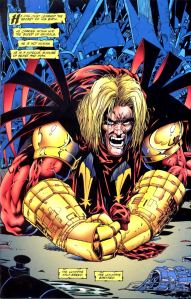Knightfall – The Bat Is Broken
It’s said that a hero is only as good as the villain he fights. For Batman, that penultimate villain is Bane. For over seventy years, villains like the Joker and Two-Face have tried to defeat Batman. Yet their failures is Bane’s victory: he broke Batman’s spine, triggering a multi-comic storyline that examines and ultimately re-defines the Dark Knight’s purpose. The Knightfall story is the first chapter of that saga.
Knightfall introduces Bane, a man born in the Pena Duro prison. Following a slight imposed on the prison’s corrupt warden, Bane spends most of his adolescence in an underground pit. Every inmate condemned into the pit eventually go insane. Not Bane. Using his hatred and his mind, Bane thrives in the pit. When he emerges from the pit, Bane finds himself a legend to the other inmates, becoming the prison’s de facto ruler.
Jealous, the warden submits Bane to experiments involving the Venom steroid. Bane’s endurance is put to the test, but once again Bane succeeds where previous subjects fail. Augmented by Venom, Bane has the extraordinary strength to match his already formidable intellect. Having achieved the physical and mental perfection he desired, Bane breaks out of prison. His goal? To defeat Batman and control Gotham City.
Instead of a direct assault, Bane instead frees most of Batman’s rogue gallery in a bid to tax the Dark Knight’s endurance to its lowest ebb. Only then does Bane strike, breaking Batman’s spine as a symbolic victory and a sign of his ascension of Gotham’s criminal kingdom.
With Batman out of commission, Bruce Wayne selects former assassin Jean-Paul Valley over original protégé Dick Grayson to be his successor, citing Grayson’s solo vigilante career as justification. With the Batman mantle secured, Wayne can focus on his rehabilitation with the help of Dr. Kinsolving, a physician whose patients include Jack Drake, the mentally-crippled father of Tim Drake (the current Robin). With her renowned healing abilities, Bruce is making significant strides in his recovery.
Unfortunately, Kinsolving is abducted right before Bruce’s eyes. Traumatized by his uselessness – and convinced that Kinsolving is the only hope for complete recovery – Bruce chases after Kinsolving.
Meanwhile, things are taking an ugly turn in Gotham. Valley proves himself a darker Batman, focusing more on punishing criminals over saving lives. Things come to a head when an encounter with Scarecrow’s fear toxin unlocks Valley’s alternate Azrael persona (derived from intense brainwashing from the extremist St. Dumas cult). Knightfall ends with Bane’s defeat at Valley’s hands. Batman once again rules the night . . . but a Batman who struggles for his sanity.
A hero is only as good as the villain he’s fighting. Bane leveled the playing field by doing the impossible: breaking Batman. Knightfall gives Bruce Wayne a new path: a life without Batman. We can only wait and see how that story unfolds.








